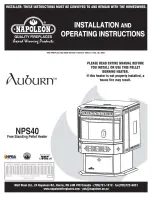
13
MONTHLY MAINTENANCE
Cleaning Stove Flue Pathways
It is recommended that the flue pathways in the
stove are cleaned on a monthly basis (or less
depending on the soot build-up created by the fuel
being used) and the chimney cleaned annually. To
access the chimney pathways, use the following
procedure:
1.
Lift up the front of the bottom baffle to allow
the two side bricks to drop into the firebox &
be removed (see Fig 12).
2.
Angle the fire fence back into the firebox to
allow it to be removed.
3.
Angle the bottom baffle up on the RHS to
allow the LH edge of the baffle to drop into
the firebox, allowing for its removal.
4.
Lift the back of the top baffle upwards, whilst
pushing it back to allow the front edge to
drop into the firebox (see Fig 13).
5.
Replace the components in reverse order
when cleaning is complete, ensuring that the
long face of the top baffle is facing
downwards when fitted.
PERIODIC MAINTENANCE
Adjusting the Door Catch
Over time, the fire door latch can loosen due to the
continual compression and hardening of the rope
seal between the door and the front casting. The
tightness of the door seal should be checked peri-
odically and it is recommended that the rope seals
on the stove are changed at least every
two years or sooner if the seal loses its integrity.
CHIMNEY CLEANING
The chimney should be cleaned twice annually or if
the stove is not used for a prolonged period during
the summer period, it should be cleaned prior to
commencement of usage. The chimney can be
cleaned through the stove depending on the flue
configuration and the flue liner should be cleaned in
accordance with manufacturer's instructions. Always
use a brush with plastic bristles that is the correct
size to reach all areas of the flue.
GLASS CLEANING
The stove glass will self-clean when there is suffi-
cient heat generated by the burning fuel i.e. when
the unit is operated at the maximum air settings. If a
build-up of creosote occurs on the glass it may be
due to low draft conditions, poor quality fuel or oper-
ating the stove at the minimum air settings for long
periods of time. The glass should be cleaned when
cool and cleaned with a non-abrasive cloth using
warm soapy water. For stubborn deposits, a grade 0
steel wool can be used whilst taking care not to
scratch the glass with any coal/ash deposits.
CLEANING A MATT BLACK/ SENOTHERM
STOVE
Cleaning should be done when the stove is cold by
removing any dust or dirt using a dry cloth. Do not
use any water on the matt black/senotherm finish as
this will cause it to rust.
PROLONGED PERIODS OF NON USE
If the stove is to be left unused for a prolonged peri-
od of time then it should be given a thorough clean
to remove ash and unburned fuel residues. To
enable a good flow of air through the appliance to
reduce condensation and subsequent damage,
leave the air controls fully open.
It is important that the flue connection, any appliance
baffles or throat plates and the chimney are swept
prior to lighting up after a prolonged shutdown peri-
od.
Fig.12
Fig.13
Lift Bottom Baffle
Drop Top Edge
of Side Brick
Drop Top Edge
of Side Brick
Lift Back Edge Up
& Push Backwards


































